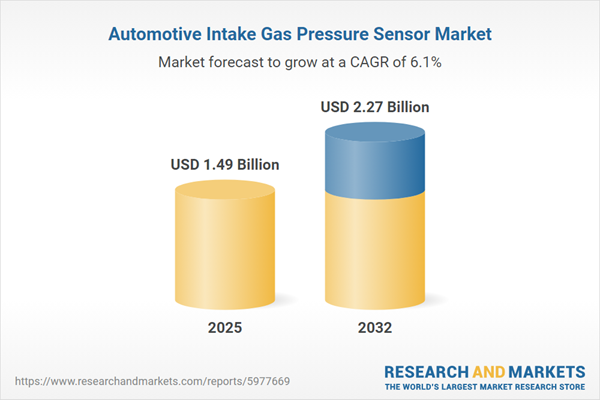Speak directly to the analyst to clarify any post sales queries you may have.
Automotive intake gas pressure sensors are driving a new era in vehicle management, shaping strategic approaches for senior automotive executives. Their integration into modern fleets is enabling smarter operations, tighter regulatory alignment, and more resilient supply chains—factors that are transforming business models and competitive positioning across the sector.
Market Snapshot: Automotive Intake Gas Pressure Sensor Market Performance
The automotive intake gas pressure sensor market is currently valued at USD 1.41 billion in 2024 and is forecast to reach USD 1.49 billion by 2025, expanding further to USD 2.27 billion by 2032. The sector is advancing at a 6.10% CAGR as stable, ongoing demand for enhanced engine management, advanced diagnostics, and compliance solutions further accelerates adoption. Automotive OEMs and suppliers are responding to shifting regulatory landscapes, prioritizing digital and miniaturized sensor solutions that simplify calibration and enable scalable analytics. Steady investments in innovation are supporting market resilience, promoting continuity of operations, and mitigating supply chain volatility across major global regions.
Scope & Segmentation: Strategic Structure for the Automotive Intake Gas Pressure Sensor Market
- Vehicle Types: Includes heavy commercial vehicles, light commercial vehicles, and passenger cars, each segment tailored to distinct efficiency and fleet requirements.
- Distribution Channels: Covers aftermarket suppliers, authorized dealers, independent service providers, and tiered supplier networks, collectively facilitating efficient inventory turnover and consistent delivery.
- Engine Types: Addresses demands for both gasoline and diesel engines, enabling adaptability to evolving combustion technologies and regional emissions mandates.
- Sensor Types: Comprises absolute, differential, and gauge sensors, delivering essential air-fuel measurement while supporting proactive maintenance with robust system diagnostics.
- Technologies: Utilizes capacitive, piezoresistive, MEMS, thick film, and piezoelectric solutions to ensure accuracy, durability, and regulatory compatibility globally.
- Sales Channels: Available through direct retail, dealerships, and advanced digital procurement systems, making sensor acquisition streamlined for distributors and OEMs.
- Pressure Ranges: Full offering spans above ten bar, five to ten bar, and sub-five bar applications, addressing varying engine specifications and regional compliance needs.
- Regions: Encompasses the Americas, Europe, Middle East & Africa, and Asia-Pacific, where unique regulatory environments and supply infrastructures affect demand strategies and sourcing decisions.
- Key Companies: Features key players such as Robert Bosch GmbH, Denso Corporation, Continental AG, Aptiv PLC, Sensata Technologies, HELLA GmbH & Co. KGaA, Valeo SA, Honeywell International, TE Connectivity, and Infineon Technologies AG, whose global reach underpins widespread technology adoption.
Key Takeaways for Senior Decision-Makers
- Intake gas pressure sensors are central to adaptive engine control systems, providing precise diagnostics that improve the reliability and maintenance of vehicle components.
- Advancements in compact and electronically integrated sensor designs are extending operational lifespans while facilitating compliance with fast-evolving emissions standards worldwide.
- Growing demand for hybrid and electric vehicles is broadening the scope of sensor deployments, prompting the need for agile production and innovative procurement strategies among suppliers.
- Collaboration among manufacturers, technology providers, and engineering teams enhances predictive maintenance capabilities and elevates diagnostics, strengthening the value chain’s overall effectiveness.
- Engagement with strong, regionally responsive supplier networks enables a more agile response to regulatory modifications and reinforces supply chain resilience amid market fluctuations.
Tariff Impact and Strategic Adjustments
- Ongoing changes in tariff regulations, especially within the United States, are prompting increased investments in localized manufacturing and diversification of sourcing networks for greater logistical resilience.
- Product design and sourcing teams frequently evaluate materials and component strategies, aiming to maintain high quality, manage operational costs, and align with shifting compliance criteria.
- Distribution partners and aftermarket providers adopt adaptive inventory management models to limit trade-related disruptions and uphold continuous service for automotive stakeholders.
Methodology & Data Sources
Market analysis is grounded in executive-level interviews with OEMs and key suppliers, supported by reviews of up-to-date industry reports, regulatory documentation, and verified third-party datasets. All findings are rigorously cross-validated to ensure objective and accurate reporting.
Why This Report Matters
- Enables senior procurement, compliance, and operations leaders to recognize new technology trajectories and policy developments impacting demand for automotive intake gas pressure sensors.
- Offers granular segmentation, empowering more targeted sourcing tactics and investment prioritization in both mature and emerging regional markets.
- Supports risk assessment and enhanced supply planning, equipping stakeholders with strategies for stronger compliance controls and improved strategic outcomes.
Conclusion
This report provides actionable market intelligence for senior decision-makers navigating the evolving landscape of automotive intake gas pressure sensors, supporting compliance mastery and robust investment planning across global markets.
Additional Product Information:
- Purchase of this report includes 1 year online access with quarterly updates.
- This report can be updated on request. Please contact our Customer Experience team using the Ask a Question widget on our website.
Table of Contents
3. Executive Summary
4. Market Overview
7. Cumulative Impact of Artificial Intelligence 2025
Companies Mentioned
The companies profiled in this Automotive Intake Gas Pressure Sensor market report include:- Robert Bosch GmbH
- Denso Corporation
- Continental AG
- Aptiv PLC
- Sensata Technologies, Inc.
- HELLA GmbH & Co. KGaA
- Valeo SA
- Honeywell International Inc.
- TE Connectivity Ltd.
- Infineon Technologies AG
Table Information
| Report Attribute | Details |
|---|---|
| No. of Pages | 187 |
| Published | October 2025 |
| Forecast Period | 2025 - 2032 |
| Estimated Market Value ( USD | $ 1.49 Billion |
| Forecasted Market Value ( USD | $ 2.27 Billion |
| Compound Annual Growth Rate | 6.1% |
| Regions Covered | Global |
| No. of Companies Mentioned | 11 |









